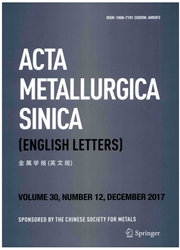

 中文摘要:
中文摘要:
In this paper, a Fe–Mn–Al–C austenitic steel with certain addition of Cr and N alloy was used as experimental material. By using the SETSYS Evolution synchronous differential thermal analysis apparatus, the scanning electron microscope(SEM), the electron microprobe(EPMA) and the X-ray diffraction(XRD), the high-temperature oxidation behavior microstructure and the phase compositions of this steel in air at 600–1,000 °C for 8 h have been studied. The results show that in the whole oxidation temperature range, there are three distinct stages in the mass gain curves at temperature higher than 800 °C and the oxidation process can be divided into two stages at temperature lower than 800 °C.At the earlier stage the gain rate of the weight oxidized in temperature range of 850 °C to 1,000 °C are extremely lower.The oxidation products having different surface microstructures and phase compositions were produced in oxidation reaction at different temperatures. The phase compositions of oxide scale formed at 1,000 °C are composed of Fe and Mn oxide without Cr. However, protective film of Cr oxide with complicated structure can be formed when the oxidation temperature is lower than 800 °C.
 英文摘要:
英文摘要:
In this paper, a Fe-Mn-Al-C austenitic steel with certain addition of Cr and N alloy was used as experimental material. By using the SETSYS Evolution synchronous differential thermal analysis apparatus, the scanning electron microscope (SEM), the electron microprobe (EPMA) and the X-ray diffraction (XRD), the high-temperature oxidation behavior microstructure and the phase compositions of this steel in air at 600-1,000 ℃ for 8 h have been studied. The results show that in the whole oxidation temperature range, there are three distinct stages in the mass gain curves at temperature higher than 800 ℃ and the oxidation process can be divided into two stages at temperature lower than 800 ℃. At the earlier stage the gain rate of the weight oxidized in temperature range of 850 ℃ to 1,000 ℃ are extremely lower. The oxidation products having different surface microstructures and phase compositions were produced in oxidation reaction at different temperatures. The phase compositions of oxide scale formed at 1,000 ℃ are composed of Fe and Mn oxide without Cr. However, protective film of Cr oxide with complicated structure can be formed when the oxidation temperature is lower than 800 ℃.
 同期刊论文项目
同期刊论文项目
 同项目期刊论文
同项目期刊论文
 期刊信息
期刊信息
